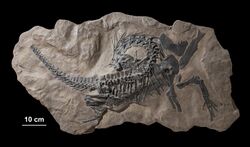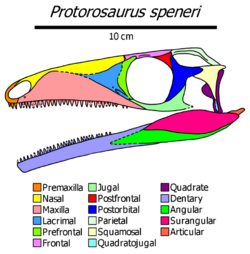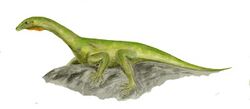Biology:Protorosaurus
| Protorosaurus | |
|---|---|

| |
| Fossil specimen, Teyler's Museum | |

| |
| Skull diagram | |
| Scientific classification | |
| Domain: | Eukaryota |
| Kingdom: | Animalia |
| Phylum: | Chordata |
| Class: | Reptilia |
| Clade: | Archelosauria |
| Clade: | Archosauromorpha |
| Genus: | †Protorosaurus von Meyer 1830 |
| Species: | †P. speneri
|
| Binomial name | |
| †Protorosaurus speneri von Meyer 1830
| |
Protorosaurus (from Greek: πρότερος próteros, 'earlier' and Greek: σαῦρος saûros, 'lizard')[1] is an extinct genus of reptile. Members of the genus lived during the late Permian period in what is now Germany and Great Britain. Once believed to have been an ancestor to lizards, Protorosaurus is now known to be one of the oldest and most primitive members of Archosauromorpha, the group that would eventually lead to archosaurs such as crocodilians and dinosaurs.[2]
Description
Protorosaurus grew up to 2 metres (6.6 ft) in length, and was a slender, lizard-like animal, vaguely resembling a monitor lizard, with long legs and a long neck.[2]
Discovery
Protorosaurus was one of the first fossil reptiles to be described, being initially described in Latin in 1710 by Christian Maximilian Spener from a specimen found in Thuringia in Germany, who considered the animal to be a crocodile, and most similar to the Nile crocodile (C. niloticus).[3] Over a century later, in publications in 1830 and 1832 Hermann von Meyer recognised Protorosaurus as distinct extinct reptile and gave it a formal species description, dedicating an extensive monograph to it in 1856. In 1871 Thomas Henry Huxley erected the clade Protorosauria, with Protorosaurus as the only member.[4] The German specimens were found in the Kupferschiefer a widespread unit of Late Permian (likely Wuchiapingian) age.[5]
In 1914, a new ceratopsian dinosaur found by Lawrence Lambe was again given the name Protorosaurus (in this sense meaning "before Torosaurus"). When Lambe found that the name had already been used for the early archosauromorph, he renamed his ceratopsian Chasmosaurus.
In 1870, a new species, Protorosaurus huxleyi was described from a railway cutting near Middridge in County Durham in northern England, in sediments belonging to the Marl Slate, a unit that is equivalent to the Kupferschiefer, however it was later shown that this specimen was not Protorosaurus, and it was subsequently placed in the new genus Adelosaurus. In 1993, a specimen of Protorosaurus was described from Quarrington Quarry also in County Durham, in sediments of the Marl Slate. This skeleton included fragments of the skull that had not previously been known.[5] A thorough redescription of Protorosaurus was published in 2009, including a specimen with a complete skull.[2]
Paleobiology
Stomach contents of a specimen of Protorosaurus show the presence of numerous ovules of the locally common voltzialean conifer Ullmannia frumentaria, which was unexpected given its unspecialised dentiton of conical and unserrated teeth, which were assumed to represent a predatory lifestyle. Along with the coniferous ovules, several rounded pebbles were found in the body cavity, these may have functioned as gastroliths.[6]
Relationships
Protorosaurus has been suggested to be closely related to Czatkowiella from the Early Triassic of Poland,[7] but the remains of Czatkowiella are fragmentary and mixed in with those of other reptiles, so it is possible that the taxon is a chimaera.[4] In a comprehensive analysis of "Protorosauria" in 2021, Protorosaurus was consistently recovered as the earliest diverging member of Archosauromorpha.[4]
The cladogram below follows an analysis by Ezcurra (2016), and highlights the position of Protorosaurus among other early archosauromorph reptiles.[8]
| Archosauromorpha |
| |||||||||||||||||||||||||||||||||||||||||||||||||||
Paleoenvironment
The Kupferschiefer and equivalent Marl Slate is a marine unit that forms part of the Zechstein, a sequence of rocks formed on the edge of the Zechstein Sea, a large inland shallow sea that existed in Northern Europe during the Late Permian. The environment at the time of deposition is considered to have been semi-arid. The terrestrial flora of the Zechstein is dominated by conifers, with seed ferns also being common, while taeniopterids, ginkgophytes and sphenophytes are rare. Other terrestrial vertebrates found in the Kupfershiefer and lower Zechstein include the gliding weigeltisaurid reptiles Weigeltisaurus and Glaurung, the pareiasaur Parasaurus, the cynodont Procynosuchus, and indeterminate captorhinids, dicynodonts, and dissorophid temnospondyls.[9][10][11][12]
References
- ↑ Colbert, Edwin H. (Edwin Harris); Knight, Charles Robert (1951). The dinosaur book : the ruling reptiles and their relatives. New York: McGraw-Hill. p. 153. https://archive.org/details/bookruli00colb.
- ↑ 2.0 2.1 2.2 Gottmann-Quesada, Annalise; Sander, P. Martin (2009-03-19). "A redescription of the early archosauromorph Protorosaurus speneri Meyer, 1832, and its phylogenetic relationships". Palaeontographica Abteilung A 287 (4–6): 123–220. doi:10.1127/pala/287/2009/123. ISSN 0375-0442. https://www.researchgate.net/publication/260391499.
- ↑ Spener CM. 1710. Disquisitio de crocodilo in lapide scissili expresso, aliisque Lithozois Miscellanea Berolinensia ad incrementum scientiarum ex scriptis Societati Regiae Scientiarum exhibitis 1:92-110
- ↑ 4.0 4.1 4.2 Spiekman, Stephan N. F.; Fraser, Nicholas C.; Scheyer, Torsten M. (2021-05-03). "A new phylogenetic hypothesis of Tanystropheidae (Diapsida, Archosauromorpha) and other "protorosaurs", and its implications for the early evolution of stem archosaurs" (in en). PeerJ 9: e11143. doi:10.7717/peerj.11143. ISSN 2167-8359. PMID 33986981.
- ↑ 5.0 5.1 Evans, S. E.; King, M. S. (May 1993). "A new specimen of Protorosaurus (Reptilia: Diapsida) from the Marl Slate (late Permian) of Britain" (in en). Proceedings of the Yorkshire Geological Society 49 (3): 229–234. doi:10.1144/pygs.49.3.229. ISSN 0044-0604. http://pygs.lyellcollection.org/lookup/doi/10.1144/pygs.49.3.229.
- ↑ Karlsruhe, Wolfgang Munk; Sues, Hans-Dieter (June 1993). "Gut contents of Parasaurus (Pareiasauria) and Protorosaurus (Archosauromorpha) from the Kupferschiefer (Upper Permian) of Hessen, Germany" (in en). Paläontologische Zeitschrift 67 (1): 169–176. doi:10.1007/BF02985876. https://doi.org/10.1007/BF02985876.
- ↑ Borsuk–Białynicka, M.; Evans, S.E. (2009). "A long–necked archosauromorph from the Early Triassic of Poland". Palaeontologia Polonica 65: 203–234. http://palaeontologia.pan.pl/PP65/PP65_203-234.pdf.
- ↑ Ezcurra, Martín D. (2016). "The phylogenetic relationships of basal archosauromorphs, with an emphasis on the systematics of proterosuchian archosauriforms". PeerJ 4: e1778. doi:10.7717/peerj.1778. PMID 27162705.
- ↑ Bernardi, Massimo; Petti, Fabio Massimo; Kustatscher, Evelyn; Franz, Matthias; Hartkopf-Fröder, Christoph; Labandeira, Conrad C.; Wappler, Torsten; Van Konijnenburg-Van Cittert, Johanna H.A. et al. (2017-12-01). "Late Permian (Lopingian) terrestrial ecosystems: A global comparison with new data from the low-latitude Bletterbach Biota" (in en). Earth-Science Reviews 175: 18–43. doi:10.1016/j.earscirev.2017.10.002. ISSN 0012-8252. Bibcode: 2017ESRv..175...18B.
- ↑ Witzmann, Florian (2005-05-31). "A dissorophid temnospondyl in the Upper Permian Kupferschiefer of Germany" (in en). Neues Jahrbuch für Geologie und Paläontologie - Monatshefte 2005 (5): 289–300. doi:10.1127/njgpm/2005/2005/289. ISSN 0028-3630. http://www.schweizerbart.de/papers/njgpm/detail/2005/91970/A_dissorophid_temnospondyl_in_the_Upper_Permian_Ku?af=crossref.
- ↑ Sues, Hans-Dieter; Munk, Wolfgang (March 1996). "A remarkable assemblage of terrestrial tetrapods from the Zechstein (Upper Permian: Tatarian) near Korbach (northwestern Hesse)" (in en). Paläontologische Zeitschrift 70 (1–2): 213–223. doi:10.1007/BF02988279. ISSN 0031-0220. http://link.springer.com/10.1007/BF02988279.
- ↑ Bulanov, V. V.; Sennikov, A. G. (2015-12-01). "Glaurung schneideri gen. et sp. nov., a new weigeltisaurid (Reptilia) from the Kupfershiefer (Upper Permian) of Germany" (in en). Paleontological Journal 49 (12): 1353–1364. doi:10.1134/S0031030115120035. ISSN 1555-6174. https://doi.org/10.1134/S0031030115120035.
Wikidata ☰ Q134702 entry
 |



